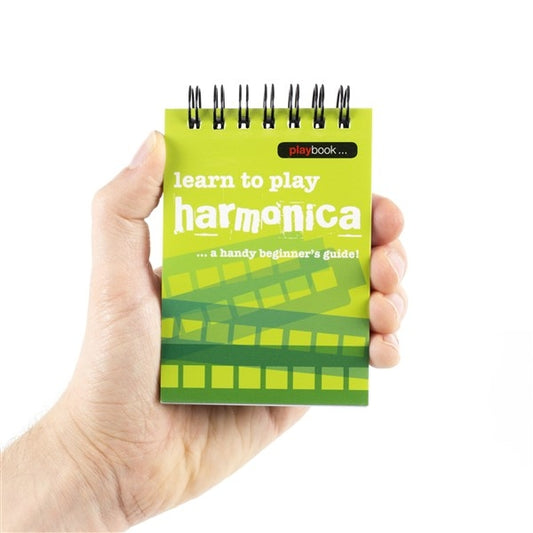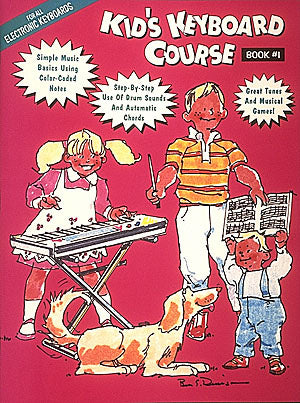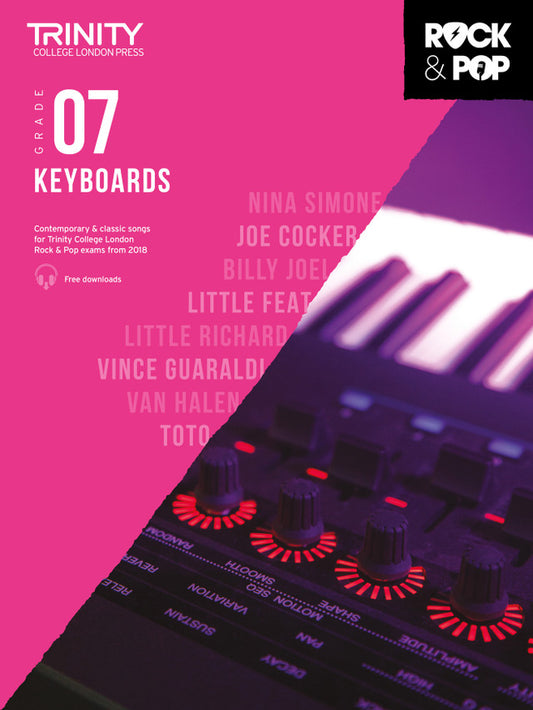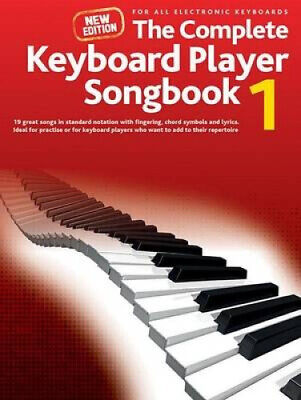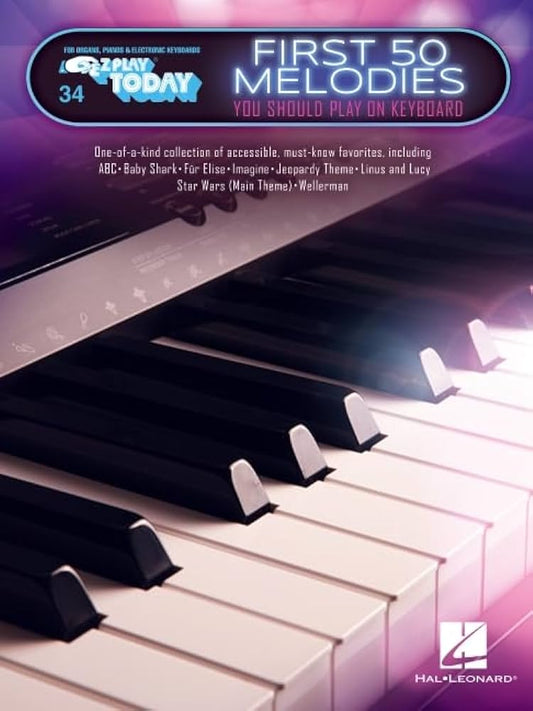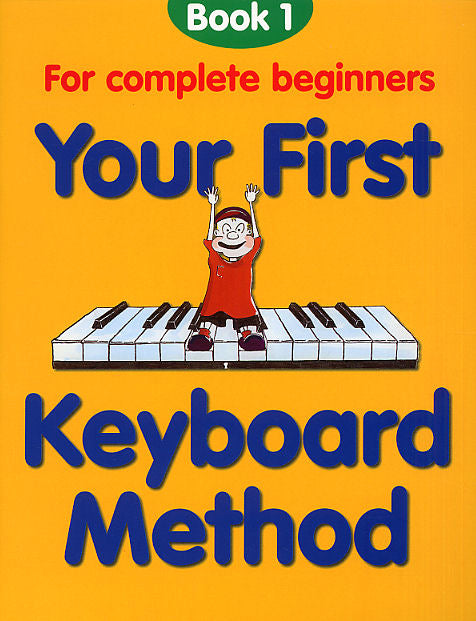-
IMP Kbd Indicator
Regular price £3.50Regular priceUnit price / per -
EKL Essent Chord Dictionary Kbd HIP FM
Regular price £5.50Regular priceUnit price / per -
PROG Kbd Yng Beg1 Bk+CD+DVD
Regular price £10.95Regular priceUnit price / per -
Playbook Learn to play Harmonica AM
Regular price £5.50Regular priceUnit price / per -
Kids Keyboard Course Bk1 HL
Regular price £4.50Regular priceUnit price / per -
Comp Kbd Player Chord Book Gigbag Bk
Regular price £7.99Regular priceUnit price / per -
Trinity Rock & Pop Keyboards Grade 7
Regular price £22.95Regular priceUnit price / per -
The Complete Keyboard Player Songbook 1
Regular price £13.99Regular priceUnit price / per -
EZ Play First 50 Melodies Kbd HL
Regular price £18.99Regular priceUnit price / per -
18 short preludes Bach
Regular price £9.95Regular priceUnit price / per -
Rock Keboard for Beginners Method ALF B
Regular price £6.95Regular priceUnit price / per -
Easy Keboard Library James Bond 007
Regular price £9.99Regular priceUnit price / per -
EKL Trad Irish Favourites Kbd FM
Regular price £8.99Regular priceUnit price / per -
Mini E-Z Vol6 Fav Songs 3 Chords HL A5
Regular price £6.99Regular priceUnit price / per -
Comp Kbd Player Dinner Jazz
Regular price £9.95Regular priceUnit price / per -
EKC Robbie Williams Keyboard AM
Regular price £9.95Regular priceUnit price / per -
Comp Kbd Player Bk2+CD Classic
Regular price £9.95Regular priceUnit price / per -
Your First Kbd Method Bk1 Beginners CH
Regular price £3.99Regular priceUnit price / per -
EKC Swing Keyboard AM
Regular price £9.95Regular priceUnit price / per -
Easy Keyboard Library Motown Classics
Regular price £9.99Regular priceUnit price / per
Collection:
Description of Keyboard Sheet Music
Keyboard sheet music is written notation specifically designed for keyboard instruments like the piano, organ, harpsichord, and synthesizers. While the basic structure of keyboard sheet music often remains similar across instruments, there are differences in how the music is notated, depending on the specific instrument's capabilities and the musical context.
For the piano and similar instruments, keyboard sheet music typically features two staves:
- Treble Clef: Used for the right hand, indicating higher-pitched notes.
- Bass Clef: Used for the left hand, indicating lower-pitched notes.
In some cases, additional clefs or staves may be used for more complex pieces, such as organ music, which may have three or more staves for different manuals (keyboards) and pedals. Keyboard sheet music also includes various musical symbols like:
- Notes (which indicate pitch and duration)
- Time and Key Signatures
- Dynamics (e.g., piano for soft, forte for loud)
- Articulations (e.g., staccato for short notes, legato for smooth notes)
- Pedal markings (specific to the piano or organ)
- Accidentals (sharps, flats, naturals)
History of Keyboard Sheet Music
The history of keyboard sheet music mirrors the development of keyboard instruments, particularly the piano, organ, and harpsichord. Here's an overview of its history:
1. Early Keyboard Music (Before 1600)
In the early stages of music history, keyboard instruments like the organ and harpsichord were significant in both religious and secular settings. Early music for keyboard instruments, particularly the organ, used neumes (an early form of musical notation) to indicate general pitch and rhythm, though these early notations were quite rudimentary. The use of staff notation began to develop in the 9th and 10th centuries, particularly with the advent of polyphony (multiple independent voices).
Keyboard music in this period was usually written for organ or harpsichord, and compositions were often simple, reflecting the limited capabilities of the instruments.
2. Renaissance Period (1400–1600)
During the Renaissance, keyboard music began to grow in complexity. Composers began to write more specifically for the organ and the harpsichord, both of which were popular in church and court music. The development of the modern staff system during the 15th and 16th centuries allowed for more precise notation of rhythm and pitch, making it easier to notate for keyboard instruments.
Fugue and improvisation were common forms of music for these instruments, with composers like Johann Sebastian Bach later perfecting the fugue form on the keyboard. During this time, music was still written in a fairly simplified manner, and often musicians were expected to improvise based on a basso continuo (a system of chords written on a bass staff).
3. Baroque Period (1600–1750)
The Baroque period saw the height of keyboard music for instruments like the organ, harpsichord, and clavichord. Basso continuo (a type of shorthand notation for harmony) was a prominent feature, particularly for harpsichord and organ players. Composers such as Bach, George Frideric Handel, and Domenico Scarlatti wrote intricate keyboard works that demanded both technical skill and emotional expression.
In Baroque music, keyboard players often had more freedom to interpret the harmonic structure in their performance. The use of the ornamentation (trills, appogiaturas, etc.) became standardized in keyboard music during this period.
4. Classical Period (1750–1820)
With the invention of the fortepiano (the precursor to the modern piano) around 1700, and its later development into the modern piano, the landscape of keyboard music underwent significant change. Ludwig van Beethoven, Wolfgang Amadeus Mozart, and Franz Joseph Haydn were some of the most notable composers of the Classical period who wrote for the newly emerging piano.
The music became more structured, with clearly defined sonata form and more detailed dynamic markings. The piano's capabilities, such as its ability to play both loud and soft sounds (unlike earlier keyboard instruments), led to more expressive music. Piano sheet music of the time started to become more standardized in terms of notation and layout, with composers taking full advantage of the instrument's technical capabilities.
5. Romantic Period (1800s)
The Romantic period saw a continued evolution of the piano and an increased focus on virtuosic performances. Composers like Frédéric Chopin, Robert Schumann, Franz Liszt, and Johannes Brahms pushed the boundaries of keyboard music, with incredibly complex works that demanded mastery of technique, expression, and emotional depth.
In this period, pedal markings became more common, and the expressive use of dynamics (like sudden changes between soft and loud) was emphasized in sheet music. Piano sheet music in this era was often filled with detailed notations regarding articulation, phrasing, and pedaling.
6. 20th Century to Present
In the 20th century, keyboard music diversified with the rise of various styles, from impressionism (e.g., Claude Debussy) to jazz, ragtime, and popular music. The advent of electronic instruments like the synthesizer and electric piano also led to new notational conventions.
Modern composers like Igor Stravinsky, Sergei Rachmaninoff, and Philip Glass continued to experiment with complex harmonies, rhythms, and textures. The development of computer software and digital publishing revolutionized the creation and distribution of keyboard sheet music, making it widely accessible through online platforms.
Conclusion
Keyboard sheet music has evolved alongside the development of keyboard instruments, with the piano becoming the centerpiece of Western music. From early neumatic notation to complex, dynamic music for modern pianos and synthesizers, keyboard sheet music represents a rich tradition of both technical innovation and emotional expression. Its history reflects the broader trends in Western music, from medieval chant and Baroque ornamentation to Classical structure and Romantic virtuosity, all the way to contemporary innovations in digital music.



